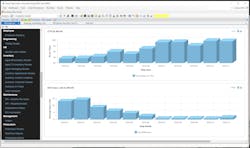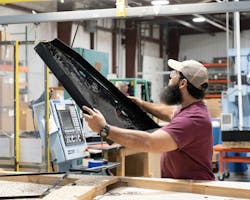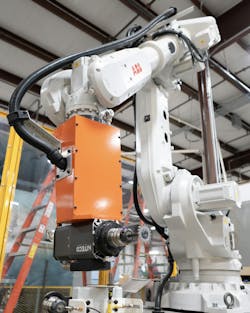ERP power user steers right data to the right people
Problem: A thermoformer was struggling with on-time delivery.
Solution: The IT director utilized DelmiaWorks' ERP system to build custom data dashboards and make production more efficient.
By Karen Hanna
Kill vermin. Collect food (or lives). Rescue the princess.
If video games are your thing, you’ve likely embarked on many adventures just like these. What if you saw work through the same lens?
One person who does is Bobby May, the IT director of SAY Plastics, a McSherrystown, Pa., thermoformer, who’s tried his hand at a bit of everything in his career, from baking pretzels at a snack factory to saving college students’ term papers as a computer lab manager. At his current job, he’s busy creating dashboards that serve up just the right information to exactly the people who need it to prioritize their tasks.
“It just simplifies things by having this list to take care of,” May said. “It’s like video games, it’s like questing.”
Late again
More than a year ago, SAY Plastics was behind. Very behind.
Of all the heavy-gauge, custom projects it shipped out in January and February 2024, around 61 percent missed deadline — by an average of more than three weeks.
That’s a long time to leave Princess Zelda waiting.
From one shift to the next, the company was stamping out parts, but it lacked cycle-to-cycle awareness to track whether it was keeping on schedule. Most of the time, it wasn’t.
It’s a phenomenon that Steve Bieszczat, CMO of DelmiaWorks, part of Dassault Systèmes, which supplies the company’s enterprise resource-planning system (ERP), knows all too well.“ERP was all about planning. You would plan it out and it would all look good on paper. But if it didn’t go right, you really didn’t know till the end of the shift, or the end of the day,” he said, of adopters of the earliest systems.
But, as Bieszczat observed, May isn’t someone to settle. At a DelmiaWorks user conference in February 2024, he found a path forward — advanced capabilities in the ERP software that would allow him to steer the right data to the right people, to empower them to make better decisions.
“Bobby is going into the database and pulling out the data that he wants to use to manage his operations and put it into dashboards to visualize it, both for his consumption and for all his co-workers’ consumption. That wasn’t normal five years ago. There’s this new normal developing where tech-savvy guys are using the ERPs as data-collection and repositories and organization systems, and then going into the database, getting the data they want, reporting it out in the way they want,” Bieszczat said. “And secondly, they’re running alerts and workflows on top of that data [for] when something happens.”
Reporting for duty
May returned from the user conference eager to push his company’s ERP usage beyond off-the-shelf reports. Rather than jamming the company’s 40-plus employees’ inboxes with generic, dated information they might easily ignore, he wanted to give them data that could help them improve their particular processes in real time.
So far, he’s created more than 120 dashboards for departments across the company, from accounting and HR to processing and shipping/receiving. He conceded it’s taken a Herculean effort, but he’s found a capable ally in the quest — the artificial intelligence of a Generative Pre-trained Transformer (GPT) program that has been trained to handle the complexities of the ERP.
“I basically lay out the tables and what I need, what information I have; I can even create a sub-structure for it. And then I put that into the GPT and say, ‘Hey, based on this, I want to see this information with this timeline,’ ” he said.
Some of the dashboards, such as lists of employee contact information and calendars updated with people’s days off, are very simple. Others get to the heart of ongoing improvement efforts, with data analyses of the productivity of a new robot, cost-per-part breakdowns by machine and, for the company’s owners, financial snapshots of the last 15 days.
“What’s great about a dashboard is it’s refreshing, and it’s got fresh data on it as the moments go by, and also they’re visual, so that a guy operating a press can see the information on it. A supervisor walking by can see the information on it, and so on,” Bieszczat said.
May said drilling down into all that data has been eye-opening.
“We started implementing that, and that kind of gave us this ability to see where our production was, and kind of be more reactive to our production, and then actually to get real information about where we should be scheduling ourselves. ... We originally had high goals of, ‘This was our production rate; this is what our OEE is supposed to be.’ And then we got a reality shock when we started getting real data and had something to strive toward.”
Timely changes
Having data that’s winnowed down to their needs has allowed the company’s decision-makers to see the problems the company might be experiencing as well as their causes. As May pointed out, you can’t fix things until you understand what’s wrong.
“You’re kind of like in the lean mentality ... when you’re diagnosing these problems for every single problem that you have, you’re doing this over and over. So, now, you have your continuous improvement process implemented in your day-to-day operation because you have that information there with you,” May said.
For SAY Plastics, that’s ushered in a new era.
“For the first time, we were able to actually view all this data that was coming in. And we were able to sit there and go, ‘OK, well, why is this running like that?’ It became that situation where, ‘OK, now, we can analyze what’s happening,’ ” he said. “Throughout the day, we could actually see what was happening. We can look at those charts, and we can see those screens light up in red and stuff like that, and go, ‘Oh no, you’re running too slow,’ or, ‘Hey, you’re running too fast,’ ” May said.
The efforts are evident throughout the company. For example, by standardizing routines and automating the tracking and reporting of key metrics and production processes, SAY Plastics is better prepared for International Organization for Standardization (ISO) audits.The company also is keeping much better time — in November and December 2024, its on-time delivery rates clocked in at 98 and 99 percent, respectively.
On average, May said, tardy deliveries are less than one day late.
He explained he created dashboards to tackle the problem of late deliveries from multiple angles.
“For our shipping department, we created a dashboard that recognized for every shipment that went out, we would go in, and it would show us the ones that need to have certain information in it, and it would also show us, ‘Here’s ones that need to be tagged up for being on time or need to be given a reason if they’re late.’ ... We now had this list that was being generated. ... We can be like, ‘OK, this is happening because of this problem. How can we solve it?’ ”
With data at the tips of their fingers, employees and managers can identify and correct issues as they occur. They also have the evidence they need to communicate with customers when the blame for scheduling issues lies outside the plant.
They’ve found that some projects get waylaid because of lack of documentation; other times, the schedule might have been too aggressive. In still other cases, customers’ vendors or materials suppliers are responsible for delays.
But unlike during SAY Plastics’ pre-dashboard days, when late deliveries might have provoked finger-pointing and aimless speculation, there’s a new transparency about what’s happening and what can be done about it.
All that has opened up communication channels, both within the plant and externally with customers.
“It’s a lot different from telling people, ‘Hey, these are late,’ and you just tell them why you think it’s late, instead of on the other side of it, ‘It’s late, here’s the data,’ ” May said. “There’s no conversation about whether your data is wrong or right, because you’ve got it right there.”
Planning for what’s next
For Bieszczat, “revolution” is a bit too strong a word to characterize the new ways companies are using data. But it’s close.
In an era that’s been marked by rapid change and tumult — from the COVID-19 pandemic to global supply disruptions — he thinks companies have to exploit every edge. In their move from shift-to-shift existence to real-time analysis, May and SAY Plastics have adopted an approach that increasingly will set some processors apart.
“Right now, manufacturers need a little bit to fight for business. ...” Bieszczat said “They’ve got to deliver, they’ve got to hit a price point, they’ve got to hit a quality point, and they’ve got to hit a delivery date. That’s what wins reoccurring business.”
He’s up for the challenge, and ready to take on the next level.
“One of our next investments may actually be the real-time process monitoring from DelmiaWorks ... because that feeds individual data, instead of cycle-based data. So it can record your temperatures, and it can record your times and stuff like that,” he said.
There’s much more to be done.
May is currently eyeing how he can funnel data to the sales and quality-control departments that they can use to improve their processes.
“I know there’s a lot more data out there,” he said.
Contact
DelmiaWorks, Dassault Systèmes, Waltham, Mass., 800-693-9000, www.delmiaworks.com
About the Author
Karen Hanna
Senior Staff Reporter
Senior Staff Reporter Karen Hanna covers injection molding, molds and tooling, processors, workforce and other topics, and writes features including In Other Words and Problem Solved for Plastics Machinery & Manufacturing, Plastics Recycling and The Journal of Blow Molding. She has more than 15 years of experience in daily and magazine journalism.




